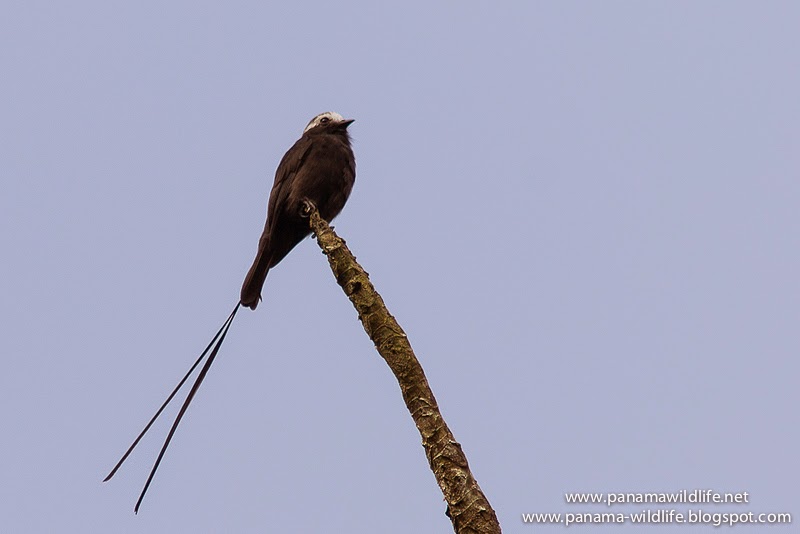Then we headed to Reserva San Francisco (San Francisco Forest Reseve) and started our half day tour in this place as planned. This was a good place to watch some birds like: Slaty-tailed Trogon, Gartered Trogon, Broad-billed Motmot, Bat Falcon, Blue-headed Parrot, Bare-crowned Antbird, Chestnut-backed Antbird, Sooty-headed Tyrannulet, Black-headed Toddy Flycatcher, Royal Flycatcher, One-colored Becard, Red-eyed Vireo, Lesser Greenlet, Golden-hooded Tanager, White-eared Conebill, Large-billed Seed-Finch, Indigo Bunting, Orange-crowned Oriole, among others. As usual, we can't always get pictures of them all.
Female Blue Ground-Dove
Male Blue Ground-Dove
The
Blue Ground-Dove (Claravis pretiosa) is a small
dove. It is a resident breeder from southeastern Mexico to northwestern Peru and northern Argentina, and on Trinidad. It's
fairly common in
almost entire country and found in
forest edge,
woodland, and shrubby areas.
Adult males have blue-grey upperparts and paler grey underparts, becoming grey-white on the face. The wings are boldly spotted black. The iris is red or yellow, the bare eyering is green, and the legs are flesh-pink. The female has a grey-brown head neck and breast, becoming pale blue-grey on the underwings and belly. The back is ruddy brown, contrasting with the chestnut rump and tail. The spots in the wings are chestnut-brown.
In most of its range, the male is unlikely to be confused with other species. The female is more likely to be confused with the female Ruddy Ground-Dove, which is smaller and has blackish (not chestnut-brown) markings on the wings. In most regions where the blue ground dove occurs, a blue grey and a brown bird flying through the trees together is bound to be both this species.
Male
Spot-crowned Barbet (Capito maculicoronatus), an
uncommon species on Caribbean slope and on the Pacific from
eastern Panamá Province eastward. Found in upper and middle levels of forest.
Plain-colored Tanager (Tangara inornata)
The
Long-tailed Tyrant (Colonia colonus) is a species in the
Tyrannidae family, and the only member of
genus Colonia. It is found in Argentina, Bolivia, Brazil, Colombia, Costa Rica, Ecuador, French Guiana, Guyana, Honduras, Nicaragua, Panama, Paraguay, Peru, Suriname, and Venezuela. In Panama it's
fairly common on entire Caribbean slope and on Pacific slope from
eastern Panamá Province eastward and in Veraguas foothills, found in
forest edge and in clearings.
The
Cinnamon Becard (Pachyramphus cinnamomeus) has been placed with the
tityras in the
cotinga or the
tyrant flycatcher families by various authors, but the evidence strongly suggest the tityras and their closest relatives are better separated. The cinnamon becard is a resident breeding species from south-eastern Mexico south to north-western Ecuador and north-western Venezuela. In Panamá is
fairly common on
both slopes, found in
woodland, forest edge, and clearings with trees.
This place was also proven to be great to watch raptors:
King Vulture (the first time I see them in the wild), Black-and-White Hawk-Eagle, Black Hawk Eagle, and White Hawk.
Immature Black Hawk-Eagle (Spizaetus tyrannus)
White Hawk (Pseudastur albicollis)
The
Barred Puffbird (Nystalus radiatus) is a species of
puffbird (
Bucconidae family). It occurs in forests in Colombia, Ecuador, and in Panama where is
uncommon in parts of the Caribbean slope, and on Pacific slope in
Darién. It's found in lower and middle levels of
forest and
adjacent clearings with trees.
After half a day exploring the area we returned to Hotel Avicar were we had a wholesome lunch (rice, lentils, spaghetti, chopped beaf, roasted chicken, green fried plantains, fried tapioca, fried ripe plantains, etc). After lunch, I was photographing hummingbirds (that will be covered in a future installment of this blog) when Guido watched a huge raptor soaring above us, I had enough opportunity to get a documentation shot, which ended being an important one. Once again we had a debate and consulted a pair of books but finally were the experts in Facebook which determined it was an immature Red-tailed Hawk. The report is important because it's one of a couple of easternmost reports of this species in Panama and we had it on picture to support it. Resident race is uncommon on western highlands, while migrant race is rare with reports as far as eastern Panamá Province.
Immature Red-Tailed Hawk (Buteo jamaicensis)
We started returning westward to Panama City with plans to make certain stops in between but the rainy weather didn't allow us. We made one stop and only a handful of birds were seen of which I got just one picture, apparently a Forest Elaenia (Myiopagis gaimardii), eating a tasty larva:
Before calling the day we made another stop at the road to Juan Diaz's Embarcadero. Were we got more birds for the tourist group's list as well as another lifer for me: Orchard Oriole.
The
Orchard Oriole (Icterus spurius) is a small North American species of
icterid blackbird. The breeding habitat is semi-open areas with deciduous trees, and breeds in spring across eastern North America from near the Canada–United States border south to central Mexico.
The adult female is described a a small, dainty oriole. bright lemon-yellow on throat and breast, duller olive on crown and back, grayish wings with faint wing-bars. It's a
common winter resident found in upper levels of forest edge, woodland, and open areas with trees, residential areas, and parks of cities and towns.





















Comments
Post a Comment